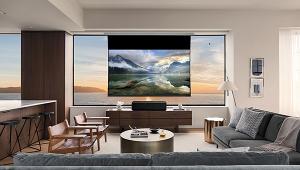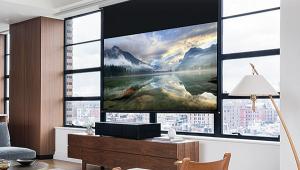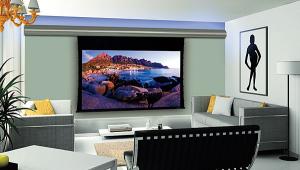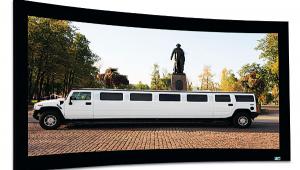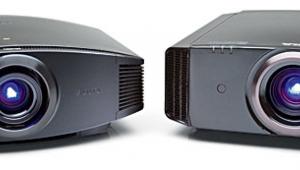Perhaps you could do a series of editor's picks for low, mid and high range setups?
The Wonderful World of Projection Screen
In a way, a projector is only as good as its screen. Or, perhaps more accurately, a good screen won’t make a bad projector look good, but a bad screen will definitely make a good projector look bad.
Almost all modern projectors can fill a 100-inch-diagonal (16x9) screen with a bright image. How much bigger you can go depends on the projector and, to a lesser extent, the gain of the screen. Keep in mind, brightness drops with screen area, not diagonal size. So a 140-inch screen will offer an image roughly half as bright as a 100-inch screen with the same projector.
You can minimize this drop to some extent by going with a higher-gain screen. The gain refers to how much more a screen reflects toward you compared with a set reference. The screens can’t “create” more light, but they can reflect more of the light toward you, sort of like focusing light at you, and letting less get scattered toward the ceiling, floor, or walls. You can’t go too high in gain without beginning to see evidence of “hotspotting,” where the center of the screen is visibly brighter than the edges. Size, hotspotting, and how much gain you want are all factors you’ll ideally work out beforehand. Because of this phenomenon, screens with really high gain will (with some exceptions) usually only look their best from a near-center seat. Purists often recommend a screen gain between 1.0 (neutral) and 1.5—though there is a vocal fan club for higher-gain screens. And if you watch a lot of 3D, you may want a higher gain; few projectors will produce a particularly bright 3D image without some help from the screen.
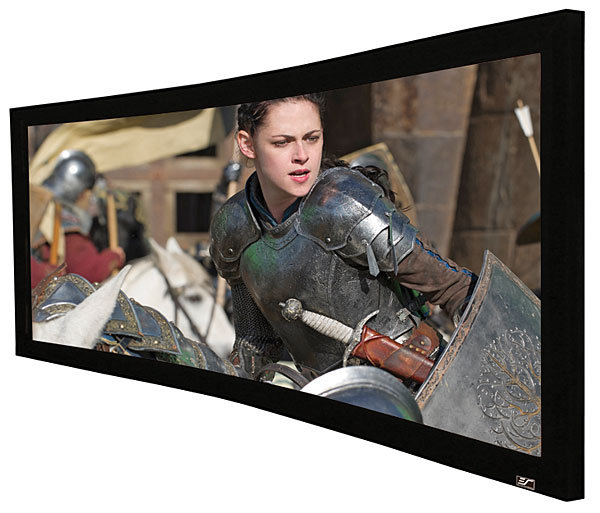
As mentioned in the article, ambient-light-rejecting screens do, more or less, as their name describes. They help minimize the picture quality loss caused by ambient light (like lights on in the room). If you’re concerned about living in a cave to watch your PJ, check these out.
Another aspect to consider is whether you want a retractable screen. These roll up (or down) when not in use. Some are manual; others are motorized. Some are wall- mountable; others can be mounted in the ceiling. There are many options. One common configuration is to have a flat-panel TV on the wall for day-to-day use and a retractable screen that drops down in front for more serious movie and sports viewing.
Rear-projection screens are less common but represent another option. The projector gets mounted behind the screen (often in another room, or in a large cabinet). Like the defunct rear-projection TVs of old, these offer some advantages, like a little better rejection of ambient light, but they also involve a more elaborate install.
For home theater setups, an “acoustically transparent” screen, usually perforated or woven, can help hide the front speakers. Dialogue comes from where it belongs at center screen, but these screens do slightly reduce image brightness, and none are perfectly transparent to sound.
If you’re on a serious budget, a lot of DIYers swear by screen paint (and some, by any paint). Screen paint has reflective properties to help it behave like a screen. Some sanding is required, as you don’t want to see the texture of your wall, but it’s an inexpensive option for those willing to put in a little labor.
It’s worth spending a decent portion of your projector research time on screens. You don’t need to spend a fortune, but don’t consider the screen an afterthought, at risk of limiting the awesomeness of your new PJ.—GM
- Log in or register to post comments


You really should have mentioned the downside of choosing a non-tensioned motorized or pull down screen, that being the fact that they will develop waves over time, which may drive some people crazy when the camera pans during a movie. The effect is distracting, looks terrible and takes away from the suspension of disbelief that we are all after during a movie. If you have to go the drop down screen route I would recommend buying a tensioned motorized or pull down screen as opposed to a non-tensioned one.

Absolutely agree with Mr. Weflen's post. I would love to get a projector but guidance is needed. An informative series with different projectors and screen combinations would be extremely helpful. Which projectors have razor sharp images(Sony, JVC, Epson)? What screens are recommended(Carada, Stewart)? Are aforementioned projectors good for gaming? I realize there are many different considerations but an article would be great. Thank you.
